Fluid Evolution, H-O Isotope and Re-Os Age of Molybdenite from the Baiyinhan Tungsten Deposit in the Eastern Central Asian Orogenic Belt, NE China, and Its Geological Significance
Abstract
1. Introduction
2. Geological Setting
3. The Baiyinhan Tungsten Deposit
4. Sampling and Analytical Methods
4.1. Samples
4.2. Analytical Methods
5. Results
5.1. Fluid Inclusion Petrography
5.1.1. C-Type (CO2-H2O Inclusions)
5.1.2. L-Type (Liquid-Rich Inclusions)
5.1.3. V-Type (Vapor-Rich Inclusions)
5.2. Microthermometry
5.3. H-O Isotopes
5.4. Re-Os Isochron Ages
6. Discussion
6.1. Evolution of Ore-Forming Fluids-the Important Role of CO2
6.2. Source of Ore-Forming Fluids and Materials
6.3. The Significance of Re-Os Age of the Baiyinhan Tungsten Deposit
7. Conclusions
Author Contributions
Funding
Acknowledgments
Conflicts of Interest
References
- Wu, F.Y.; Sun, D.Y.; Ge, W.C.; Zhang, Y.B.; Grant, M.L.; Wilde, S.A.; Jahn, B.M. Geochronology of the Phanerozoic granitoids in northeastern China. J. Asian Earth Sci. 2011, 41, 1–30. [Google Scholar] [CrossRef]
- Zeng, Q.D.; Liu, J.M.; Yu, C.M.; Ye, J.; Liu, H.T. Metal DEPOSITS in the Da Hinggan Mountains, NE China: Styles, characteristics, and exploration potential. Int. Geol. Rev. 2011, 53, 846–878. [Google Scholar] [CrossRef]
- Zeng, Q.D.; Liu, J.M.; Chu, S.X.; Wang, Y.B.; Sun, Y.; Duan, X.X.; Zhou, L.L. Mesozoic molybdenum deposits in the East Xingmeng orogenic belt, northeast China: Characteristics and tectonic setting. Int. Geol. Rev. 2012, 54, 1843–1869. [Google Scholar] [CrossRef]
- Zeng, Q.D.; Qin, K.Z.; Liu, J.M.; Li, G.M.; Zhai, M.G.; Chu, S.X.; Guo, Y.P. Porphyry molybdenum deposits in the Tianshan–Xingmeng orogenic belt, northern China. Int. J. Earth Sci. 2015, 104, 991–1023. [Google Scholar] [CrossRef]
- Ouyang, H.G.; Mao, J.W.; Santosh, M.; Zhou, J.; Zhou, Z.H.; Wu, Y.; Hou, L. Geodynamic setting of Mesozoic magmatism in NE China and surrounding regions: Perspectives from spatio–temporal distribution patterns of ore deposits. J. Asian Earth Sci. 2013, 78, 222–236. [Google Scholar] [CrossRef]
- Xu, W.L.; Pei, F.P.; Wang, F.; Meng, E.; Ji, W.Q.; Yang, D.B.; Wang, W. Spatial–temporal relationships of Mesozoic volcanic rocks in NE China: Constraints on tectonic overprinting and transformations between multiple tectonic regimes. J. Asian Earth Sci. 2013, 74, 167–193. [Google Scholar] [CrossRef]
- Sun, J.G.; Zhang, Y.; Han, S.J.; Men, L.J.; Li, Y.X.; Chai, P.; Yang, F. Timing of formation and geological setting of low-sulphidation epithermal gold deposits in the continental margin of NE China. Int. Geol. Rev. 2013, 55, 608–632. [Google Scholar] [CrossRef]
- Ren, Y.S.; Lei, E.; Zhao, H.L.; Wang, H.; Ju, N. Characteristics of fluid inclusions and ore genesis of Yangjingou large scheelite deposit in Yanbian area, NE China. J. Jilin Univ. Earth Sci. Ed. 2010, 40, 764–772. (In Chinese) [Google Scholar]
- Ren, Y.S.; Niu, J.P.; Lei, E.; Wang, H.; Wang, X. Geological&geochemical Characteristics and metallogenesis of Sanjiazi scheelite deposit in Siping area. Jilin Province. J. Jilin Univ. Earth Sci. Ed. 2010, 40, 314–320. (In Chinese) [Google Scholar]
- Ren, Y.S.; Ju, N.; Zhao, H.L.; Wang, H.; Lu, X.Q.; Wu, C.Z. Geological characteristics and fluid inclusions of Wudaogou lode scheelite deposit in eastern Yanbian, Jilin Province. J. Jilin Univ. Earth Sci. Ed. 2011, 41, 1736–1744. (In Chinese) [Google Scholar]
- Xiang, A.P.; Wang, Y.J.; Qin, D.J.; She, H.Q.; Han, Z.G.; Guan, J.D.; Kang, Y.J. Metallogenic and diagenetic age of Honghuaerji tungsten polymetallic deposit in Inner Mongolia. Miner. Depos. 2014, 33, 428–439. (In Chinese) [Google Scholar]
- Xiang, A.P.; She, H.Q.; Chen, Y.C.; Qin, D.J.; Wang, Y.J.; Han, Z.G.; Kang, Y.J. Ar-Ar age of muscovite from the greisenization alteration zones of the Honghuaerji tungsten polymetallic deposit, inner Mongolia, and its geological significance. Rock Miner. Anal. 2016, 35, 108–116. (In Chinese) [Google Scholar]
- Xiang, A.P.; Chen, Y.C.; She, H.Q.; Li, G.M.; Li, Y.X. Geochronology and geochemical characteristic of biotite granite of the Dayana W-Mo deposit in Dong Uj imqin banner, inner Mongolia, and its geological significance. Acta Geol. Sin. 2018, 92, 107–124. (In Chinese) [Google Scholar]
- Xiang, A.P.; Chen, Y.C.; She, H.Q.; Li, G.M.; Li, Y.X. Chronology and geochemical characteristics of granite in Weilianhe of Inner Mongolia and its geological significance. Geol. China 2018, 45, 963–976. (In Chinese) [Google Scholar]
- Guo, Z.J.; Li, J.W.; Chang, Y.L.; Han, Z.G.; Dong, X.Z.; Yang, Y.C.; Tian, J.; She, H.Q.; Xiang, A.P.; Kang, Y.J. Genetic types and ore-forming geological significance of granites in the Honghuaerji scheelite deposit, Inner Mongolia. Acta Petrol. Mineral. 2015, 34, 322–342. (In Chinese) [Google Scholar]
- Guo, Z.J.; Li, J.W.; Huang, M.H.; Guo, W.J.; Dong, X.Z.; Tian, J.; Yang, Y.C.; She, H.Q.; Xiang, A.P.; Kang, Y.J. Characteristics of ore-forming fluid in Honghuaerji scheelite deposit, Inner Mongolia. Miner. Depos. 2016, 35, 1–17. (In Chinese) [Google Scholar]
- Li, J.J.; Fu, C.; Tang, W.L.; Li, H.M.; Lin, Y.X.; Zhang, T.; Wang, S.G.; Zhao, Z.L.; Dang, Z.C.; Zhao, L.J. The metallogenic age of the Shamai wolframite deposit in Dong Ujimqin Banner, Inner Mongolia. Geol. Bull. China 2016, 35, 524–530. (In Chinese) [Google Scholar]
- Chen, G.Z.; Wu, G.; Li, T.G.; Liu, R.L.; Wu, L.W.; Zhang, P.C.; Zhang, T.; Chen, Y.C. LA-ICP-MS zircon and cassiterite U-Pb ages of Daolundaba copper-tungstentin deposit in Inner Mongolia and their geological significance. Miner. Depos. 2018, 37, 225–245. (In Chinese) [Google Scholar]
- Ma, Y.P.; Ren, Y.S.; Hao, Y.J.; Lai, K.; Zhao, H.L.; Liu, J. Genesis and Material Source of Scheelite of Yangbishan Iron-Tungsten Deposit in Heilongjiang, NE China. J. Jilin Univ. Earth Sci. Ed. 2018, 48, 105–117. (In Chinese) [Google Scholar]
- Yuan, X.P. Geological characteristics and genesis study of Xiaolaogualinzi W-Mo polymetallic deposit in Hexigten Banner, Inner Mongolia. Miner. Resour. Geol. 2018, 32, 276–282. (In Chinese) [Google Scholar]
- Nie, F.J.; Jiang, S.H. Geological setting and origin of Mo–W–Cu deposits in the honggor–shamai District, inner Mongolia, North China. Resour. Geol. 2011, 61, 344–355. [Google Scholar] [CrossRef]
- Hu, X.L.; Ding, Z.J.; He, M.C.; Yao, S.Z.; Zhu, B.P.; Shen, J.; Chen, B. Two epochs of magmatism and metallogeny in the Cuihongshan Fe-polymetallic deposit, Heilongjiang Province, NE China: Constrains from U-Pb and Re-Os geochronology and Lu-Hf isotopes. J. Geochem. Explor. 2014, 143, 116–126. [Google Scholar] [CrossRef]
- Zeng, Q.D.; Sun, Y.; Chu, S.X.; Duan, X.X.; Liu, J.M. Geochemistry and geochronology of the Dongshanwan porphyry Mo-W deposit, Northeast China: Implications for the Late Jurassic tectonic setting. J. Asian Earth Sci. 2015, 97, 472–485. [Google Scholar] [CrossRef]
- Guo, Z.; Li, J.; Xu, X.; Song, Z.; Dong, X.; Tian, J.; Yang, Y.; She, H.; Xiang, A.; Kang, Y. Sm-Nd dating and REE Composition of scheelite for the Honghuaerji scheelite deposit, Inner Mongolia, Northeast China. Lithos 2016, 261, 307–321. [Google Scholar] [CrossRef]
- Jiang, S.-H.; Bagas, L.; Hu, P.; Han, N.; Chen, C.L.; Liu, Y.; Kang, H. Zircon U-Pb ages and Sr-Nd-Hf isotopes of the highly fractionated granite with tetrad REE patterns in the Shamai tungsten deposit in eastern Inner Mongolia, China: Implications for the timing of mineralization and ore genesis. Lithos 2016, 261, 322–339. [Google Scholar] [CrossRef]
- Xiang, A.; Chen, Y.; Bagas, L.; She, H.; Kang, Y.; Yang, W.; Li, C. Molybdenite Re-Os and U-Pb zircon dating and genesis of the Dayana W-Mo deposit in eastern Ujumchin, Inner Mongolia. Ore Geol. Rev. 2016, 78, 268–280. [Google Scholar] [CrossRef]
- Fei, X.; Zhang, Z.; Cheng, Z.; Santosh, M.; Jin, Z.; Wen, B.; Li, Z.; Xu, L. Highly differentiated magmas linked with polymetallic mineralization: A case study from the Cuihongshan granitic intrusions, Lesser Xing’an Range, NE China. Lithos 2018, 302, 158–177. [Google Scholar] [CrossRef]
- Wang, Y.H.; Zhang, F.F.; Liu, J.J.; Xue, C.J.; Zhang, Z.C. Genesis of the Wurinitu W-Mo deposit, Inner Mongolia, northeast China: Constraints from geology, fluid inclusions and isotope systematics. Ore Geol. Rev. 2018, 94, 367–382. [Google Scholar] [CrossRef]
- Li, Y.; Yu, X.; Mi, K.; Carranza, E.J.M.; Liu, J.; Jia, W.; He, S. Deposit geology, geochronology and geochemistry of the Gongpengzi skarn Cu-Zn-W polymetallic deposit, NE China. Ore Geol. Rev. 2019, 109, 465–481. [Google Scholar] [CrossRef]
- Bureau of Geology and Mineral Resources of Neimongol Autonomous Region (BGMR). Regional Geology of Neimonggol Autonomous Region; Geological Publishing House: Beijing, China, 1991; 532p. (In Chinese) [Google Scholar]
- Wang, Y. Geological Information Were Discovered and Their Plate Tectonic Significance on the Northern Bank of Xarmoron River. Geol. Inn. Mong. 1999, 90, 6–28. (In Chinese) [Google Scholar]
- Yang, B.J.; Liu, W.S.; Wang, X.C.; Li, Q.X.; Wang, J.M.; Zhao, X.P.; Li, R.L. Geophysical characteristics of Daxinganling gravitational gradient zone in Eastern China and its geodynamic mechanism. Chin. J. Geophys. 2005, 48, 86–97. (In Chinese) [Google Scholar] [CrossRef]
- Zeng, Q.D.; Liu, J.M.; Liu, H.T. Geology and geochemistry of the Bianbianshan Au-Ag-Cu-Pb-Zn deposit, Southern Da Hinggan mountains, Northeastern China. Acta Geol. Sin. Engl. Ed. 2012, 86, 630–639. [Google Scholar]
- Zeng, Q.D.; Liu, J.M.; Chu, S.X.; Guo, Y.P.; Gao, S.; Guo, L.X.; Zhai, Y.Y. Poly-metal mineralization and exploration potential in southern segment of the Da Hinggan mountains. J. Jilin Univ. Earth Sci. Ed. 2016, 46, 1100–1123. (In Chinese) [Google Scholar]
- Xiang, G.G.; Jin, W.L.; De, H.Z.; Fei, X.; Han, B.X.; Shuai, J.W.; Tian, L.J. Petrogenesis and tectonic setting of igneous rocks from the Dongbulage porphyry Mo deposit, Great Hinggan Range, NE China: Constraints from geology, geochronology, and isotope geochemistry. Ore Geol. Rev. 2020, 120, 103326. [Google Scholar]
- Yu, B.; Zeng, Q.; Frimmel, H.E.; Wang, Y.; Guo, W.; Sun, G.; Zhou, T.; Li, J. Genesis of the Wulong gold deposit, northeastern North China Craton: Constraints from fluid inclusions, H-O-S-Pb isotopes, and pyrite trace element concentrations. Ore Geol. Rev. 2018, 102, 313–337. [Google Scholar] [CrossRef]
- Bodnar, R.J. Revised equation and table for determining the freezing point depression of H2O-NaCl solutions. Geochim. Cosmochim. Acta 1993, 57, 683–684. [Google Scholar] [CrossRef]
- Collins, P.L.F. Gas hydrates in CO2-bearing fluid inclusions and the use of freezing data for estimation of salinity. Econ. Geol. 1979, 74, 1435–1444. [Google Scholar] [CrossRef]
- Steele, M.M.; Lecumberri, S.P.; Bodnar, R.J. HokieFlincs_H2O-NaCl: A Microsoft Excel spreadsheet for interpreting microthermometric data from fluid inclusions based on the PVTX properties of H2O-NaCl. Comput. Geosci. 2012, 49, 334–337. [Google Scholar] [CrossRef]
- Clayton, R.N.; Mayeda, T.K. The use of bromine pentafluoride in the extraction of oxygen from oxides and silicates for isotopic analysis. Geochim. Cosmochim. Acta 1963, 27, 43–52. [Google Scholar] [CrossRef]
- Simon, K. Does δD from fluid inclusion in quartz reflect the original hydrothermal fluid? Chem. Geol. 2001, 177, 483–495. [Google Scholar] [CrossRef]
- Clayton, R.N.; O’Neil, J.L.; Mayeda, T.K. Oxygen isotope exchange between quartz and water. J. Geophys. Res. 1972, 77, 3057–3067. [Google Scholar] [CrossRef]
- Du, A.D.; He, H.L.; Yin, N.W.; Zou, X.Q.; Sun, Y.L.; Sun, D.Z.; Cheng, S.Z.; Qu, W.J. A study of the rhenium-osmium geochronometry of molybdenites. Acta Geol. Sin. 1994, 68, 339–347. (In Chinese) [Google Scholar]
- Du, A.D.; Wu, S.Q.; Sun, D.Z.; Wang, S.X.; Qu, W.J.; Markey, R.; Stein, H.; Morgan, J.; Malinovskiy, D. Preparation and certification of Re-Os dating reference materials: Molybdenite HLP and JDC. Geostand. Geoanal. Res. 2004, 28, 41–52. [Google Scholar] [CrossRef]
- Shirey, S.B.; Walker, R.J. Carius tube digestion for low-blank rhenium-osmium analysis. Anal. Chem. 1995, 67, 2136–2141. [Google Scholar] [CrossRef]
- Stein, H.J.; Markey, R.J.; Morgan, J.W.; Du, A.; Sun, Y. Highly precise and accurate Re-Os ages for molybdenite from the East Qinling molybdenum belt, Shanxi Province, China. Econ. Geol. 1997, 92, 827–835. [Google Scholar] [CrossRef]
- Lu, H.Z.; Fan, H.R.; Ni, P.; Ou, G.X.; Shen, K.; Zhang, W.H. Fluid Inclusions; Science Press: Beijing, China, 2004; pp. 1–450. (In Chinese) [Google Scholar]
- Chen, L.L.; Ni, P.; Li, W.S.; Ding, J.Y.; Pan, J.Y.; Wang, J.J.; Yang, Y.L. The link between fluid evolution and vertical zonation at the Maoping tungsten deposit, Southern Jiangxi, China: Fluid inclusion and stable isotope evidence. J. Geochem. Explor. 2018, 192, 18–32. [Google Scholar] [CrossRef]
- Berzina, A.N.; Sotnikov, V.I.; Economou, E.M.; Eliopoulos, D.G. Distribution of rhenium in molybdenite from porphyry Cu-Mo and Mo-Cu deposits of Russia (Siberia) and Mongolia. Ore Geol. Rev. 2005, 26, 91–113. [Google Scholar] [CrossRef]
- Ludwig, K.R. Users Manual for Isoplot/Ex rev. 2.49; Geochronological Center Special Publication: Berkeley, CA, USA, 2001; Volume 1a, pp. 1–56. [Google Scholar]
- Smoliar, M.I.; Walker, R.J.; Morgan, J.W. Re-Os ages of groupⅡA, ⅢA, ⅣA, and ⅣB iron meteorites. Science 1996, 271, 1099–1102. [Google Scholar] [CrossRef]
- Liu, Y.J.; Ma, D.S. Geochemistry of Tungsten; Science Press: Beijing, China, 1987; pp. 1–222. (In Chinese) [Google Scholar]
- Wood, S.A.; Samson, I.M. The hydrothermal geochemistry of tungsten in granitoid environments: I. relative solubilities of ferberite and scheelite as a function of T, P, pH, and mNaCl. Econ. Geol. 2000, 95, 143–182. [Google Scholar] [CrossRef]
- Rios, F.J.; Villas, R.N.; Fuzikawa, K. Fluid evolution in the Pedra Preta wolframite ore deposit, Paleoproterozoic Musa granite, eastern Amazon craton, Brazil. J. S. Am. Earth Sci. 2003, 15, 787–802. [Google Scholar] [CrossRef]
- Li, J.K.; Liu, Y.C.; Zhao, Z.; Chou, I.M. Roles of carbonate/CO2 in the formation of quartz-vein wolframite deposits: Insight from the crystallization experiments of huebnerite in alkal-icarbonate aqueous solutions in a hydrothermal diamond-anvil cell. Ore Geol. Rev. 2018, 95, 40–48. [Google Scholar] [CrossRef]
- Xu, Y.S.; Zhang, B.; Han, Y.W. An experimental study on the partitioning of tungsten between aqueous fluid and silicate melts. Geochimica 1992, 3, 272–281. (In Chinese) [Google Scholar]
- Liu, Y.C.; Li, J.K.; Zhao, Z. A preliminary experimental study of the crystallization of wolframite using hydrothermal diamond anvil cell. Earth Sci. Front. 2017, 24, 159–166. (In Chinese) [Google Scholar]
- Higgins, N.C. Fluid inclusion evidence for the transport of tungsten by carbonate complex in hydrothermal solutions. Can. J. Earth Sci. 1980, 17, 823–830. [Google Scholar] [CrossRef]
- Drummond, S.E.; Ohmoto, H. Chemical evolution and mineral deposition in boiling hydrothermal systems. Econ. Geol. 1985, 80, 126–147. [Google Scholar] [CrossRef]
- Phillips, G.N.; Evans, K.A. Role of CO2 in the formation of gold deposits. Nature 2004, 429, 860–863. [Google Scholar] [CrossRef] [PubMed]
- Yin, X.B.; Zhang, D.H.; Wang, C.S.; Zhao, G.J. Characteristics of fluid inclusion for typical tungsten, stannary vein deposit and porphyry molybdenum deposit in China. Guilin Ligong Daxue Xuebao 2011, 31, 524–532. (In Chinese) [Google Scholar]
- Linnen, R.L.; Williams, J.A.E. The evolution of pegmatite-hosted Sn-W mineralization at Nong Sua, Thailand: Evidence from fluid inclusions and stable isotopes. Geochim. Cosmochim. Acta 1994, 58, 735–747. [Google Scholar] [CrossRef]
- Wang, X.D.; Ni, P.; Yuan, S.D.; Wu, S.H. Fluid inclusion studies of the Huangsha quartz-vein type tungsten deposit, Jiangxi Province. Acta Petrol. Sin. 2012, 28, 122–132. (In Chinese) [Google Scholar]
- Zhang, D.Q.; Feng, C.Y.; Li, D.X.; Chen, Y.C.; Zeng, Z.L. Fluid inclusions characteristics and ore genesis of Taoxikeng tungsten and tin deposit in Chongyi County, Jiangxi Province. J. Jilin Univ. Earth Sci. Ed. 2012, 42, 374–383. (In Chinese) [Google Scholar]
- Spycher, N.F.; Reed, M. Evolution of a broadlands-type epithermal ore fluid along alternative P-T paths: Implications for the transport and deposition of base, precious, and volatile metals. Econ. Geol. 1989, 84, 328–359. [Google Scholar] [CrossRef]
- So, C.S.; Yun, S.T. Origin and evolution of W-Mo-producing fluids in a granitic hydrothermal system: Geochemical studies of quartz vein deposits around the Susan Granite, Hwanggangri District, Republic of Korea. Econ. Geol. 1994, 89, 246–267. [Google Scholar] [CrossRef]
- Graupner, T.; Kempe, U.; Dombon, E.; Pätzold, O.; Leeder, O.; Spooner, E.T.C. Fluid regime and ore formation in the tungsten (-yttrium) deposits of Kyzyltau (Mongolian Altai): Evidence for fluid variability in tungsten-tin ore systems. Chem. Geol. 1999, 154, 21–58. [Google Scholar] [CrossRef]
- Liu, C.; Zhao, Z.; Lu, L.N.; Zeng, Z.L.; Liu, C.H.; Xu, H. Metallogenic fluid study of the Yanqian skarn type tungsten deposit in eastern Nanling region. Acta Geol. Sin. 2018, 92, 2485–2507. (In Chinese) [Google Scholar]
- Zhang, D.H. Some new advances in ore-forming fluid geochemistry on boiling and mixing of fluids during the progress of hydrothermal deposits. Adv. Earth Sci. 1997, 12, 546–552. (In Chinese) [Google Scholar]
- Van Hinsberg, V.J.; Berlo, K.; Migdisov, A.A.; Williams, J.A.E. CO2-fluxing collapses metal mobility in magmatic vapour. Geochem. Perspect. Lett. 2016, 2, 169–177. [Google Scholar] [CrossRef][Green Version]
- Higgins, N.C.; Kerrich, R. Progressive 18O depletion during CO2 separation from a carbon dioxide-rich hydrothermal fluid: Evidence from the Grey River tungsten deposit, Newfoundland. Can. J. Earth Sci. 1982, 19, 2247–2257. [Google Scholar] [CrossRef]
- Mangas, J.; Arribas, A. Hydrothermal fluid evolution of the Sn-W mineralization in the Parrilla ore deposit (Caceres, Spain). J. Geol. Soc. 1988, 145, 147–155. [Google Scholar] [CrossRef]
- Taylor, H.P. The application of oxygen and hydrogen isotope studies to problems of hydrothermal alteration and ore deposition. Econ. Geol. 1974, 69, 843–883. [Google Scholar] [CrossRef]
- Rye, R.O.; Ohmoto, H. Sulfur and carbon isotopes and ore genesis: A review. Econ. Geol. 1974, 69, 826–842. [Google Scholar] [CrossRef]
- Barnes, H.L. Solubilities of ore minerals. In Geochemistry of Hydrothermal Ore Deposits; Wiley-Blackwell: Hoboken, NJ, USA, 1979; pp. 404–460. [Google Scholar]
- Taylor, B.E. Degassing of H2O from rhyolite magma during eruption and shallow intrusion, and the isotopic composition of magmatic water in hydrothermal systems. Magmatic contributions to hydrothermal systems. Geol. Surv. Jpn. Rep. 1992, 279, 190–194. [Google Scholar]
- Giggenbach, W.F. Isotopic shifts in waters from geothermal and volcanic systems along convergent plate boundaries and their origin. Earth Planet. Sci. Lett. 1992, 113, 495–510. [Google Scholar] [CrossRef]
- Zeng, Q.D.; Guo, F.; Zhou, L.L.; Duan, X.X. Two periods of mineralization in Xiaoxinancha Au-Cu deposit, NE China: Evidences from the geology and geochronology. Geol. J. 2016, 51, 51–64. [Google Scholar] [CrossRef]
- Mao, J.W.; Zhang, Z.; Zhang, Z.; Du, A.D. Re-Os isotopic dating of molybdenites in the Xiaoliugou W (Mo) deposit in the northern Qian mountains and its geological significance. Geochim. Cosmochim. Acta. 1999, 63, 1815–1818. [Google Scholar]
- Mao, J.W.; Du, A.; Seltmann, R.; Yu, J.J. Re–Os ages for the Shameika porphyry Mo deposit and the Lipovy Log rare metal pegmatite, central Urals, Russia. Miner. Depos. 2003, 38, 251–257. [Google Scholar] [CrossRef]
- Zhao, H.L.; Ren, Y.S.; Ju, N.; Wang, H.; Hou, K.J. Geochronology and geochemistry of metallogenic intrusion in Baishilazi tungsten deposit of eastern Yanbian area, Northeast China. J. Jilin Univ. Earth Sci. Ed. 2011, 41, 1726–1735. (In Chinese) [Google Scholar]
- Hao, Y.J.; Ren, Y.S.; Zhao, H.L.; Zou, X.T.; Chen, C.; Hou, Z.S.; Qu, W.J. Re-Os isotopic dating of the molybdenite from the Cuihongshan W-Mo polymetallic deposit in Heilongjiang province and its geological significanc. J. Jilin Univ. Earth Sci. Ed. 2013, 43, 1840–1850. (In Chinese) [Google Scholar]
- Liu, Y. The Geological Characteristics and Prospecting Direction of Gongpengzi Cu-Zn-W Deposit in Heilongjiang Province. Master’s Thesis, Jilin University, Changchun, China, 2013. (In Chinese). [Google Scholar]
- Liang, B.S. Geological Characteristics and Genesis of Iron Polymetallic Orefield in Ergu Area, Heilongjiang Province. Master’s Thesis, Jilin University, Changchun, China, 2014. (In Chinese). [Google Scholar]
- Zhao, H.L. Ore Genesis and Geodynamic Settings of Tungsten Deposits in Eastern Jilin and Heilongjiang Provinces. Ph.D. Thesis, Jilin University, Changchun, China, 2014. (In Chinese). [Google Scholar]
- Ren, L.; Sun, J.G.; Tang, C.; Men, L.J.; Li, Y.X.; Cui, P.L. Petrogenic and metallogenic geochronology and its geological implications of Lianzhushan gold deposit, Jiayin, Heilongjiang Province. Acta Petrol. Sin. 2015, 8, 2435–2449. (In Chinese) [Google Scholar]

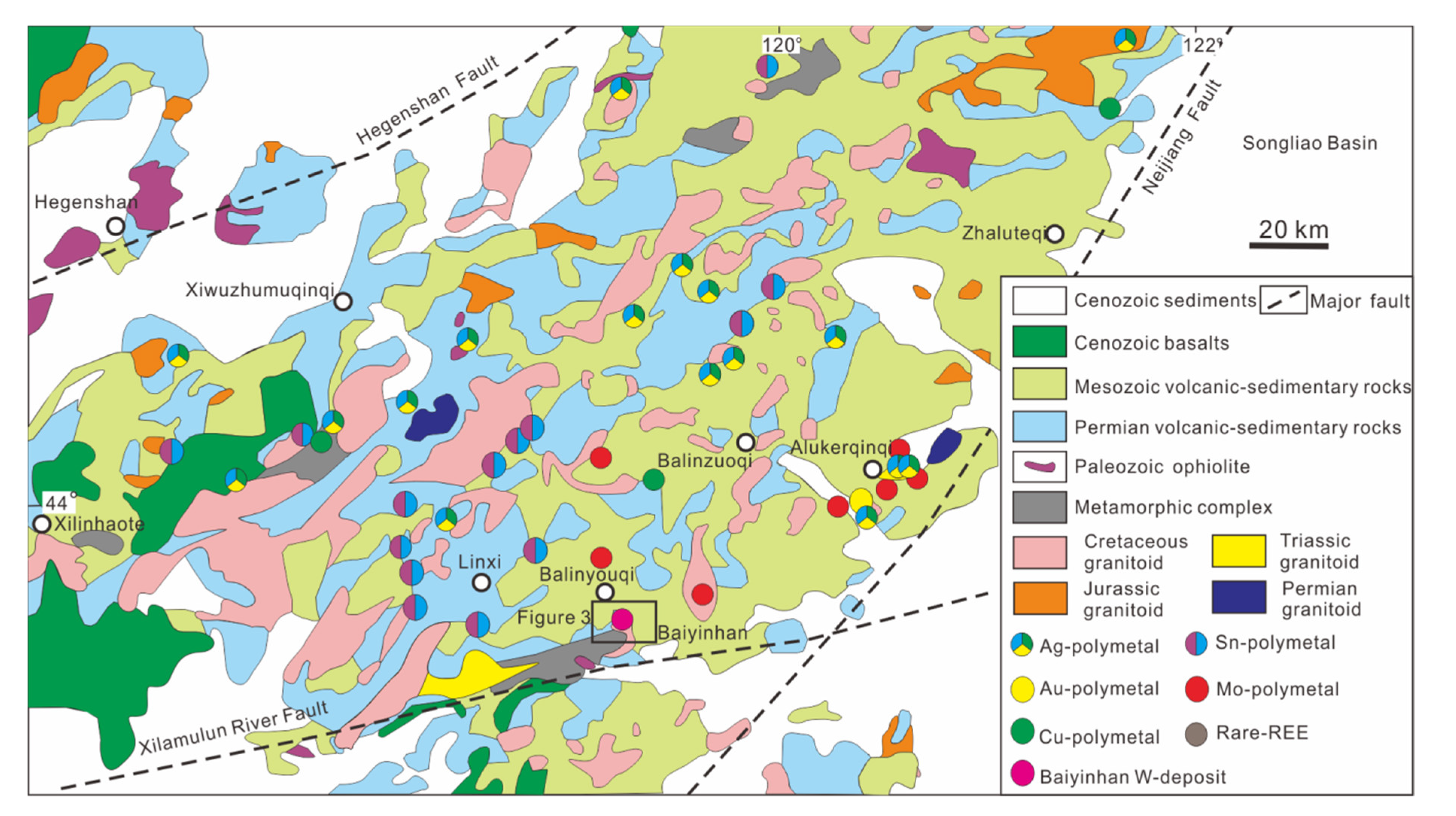
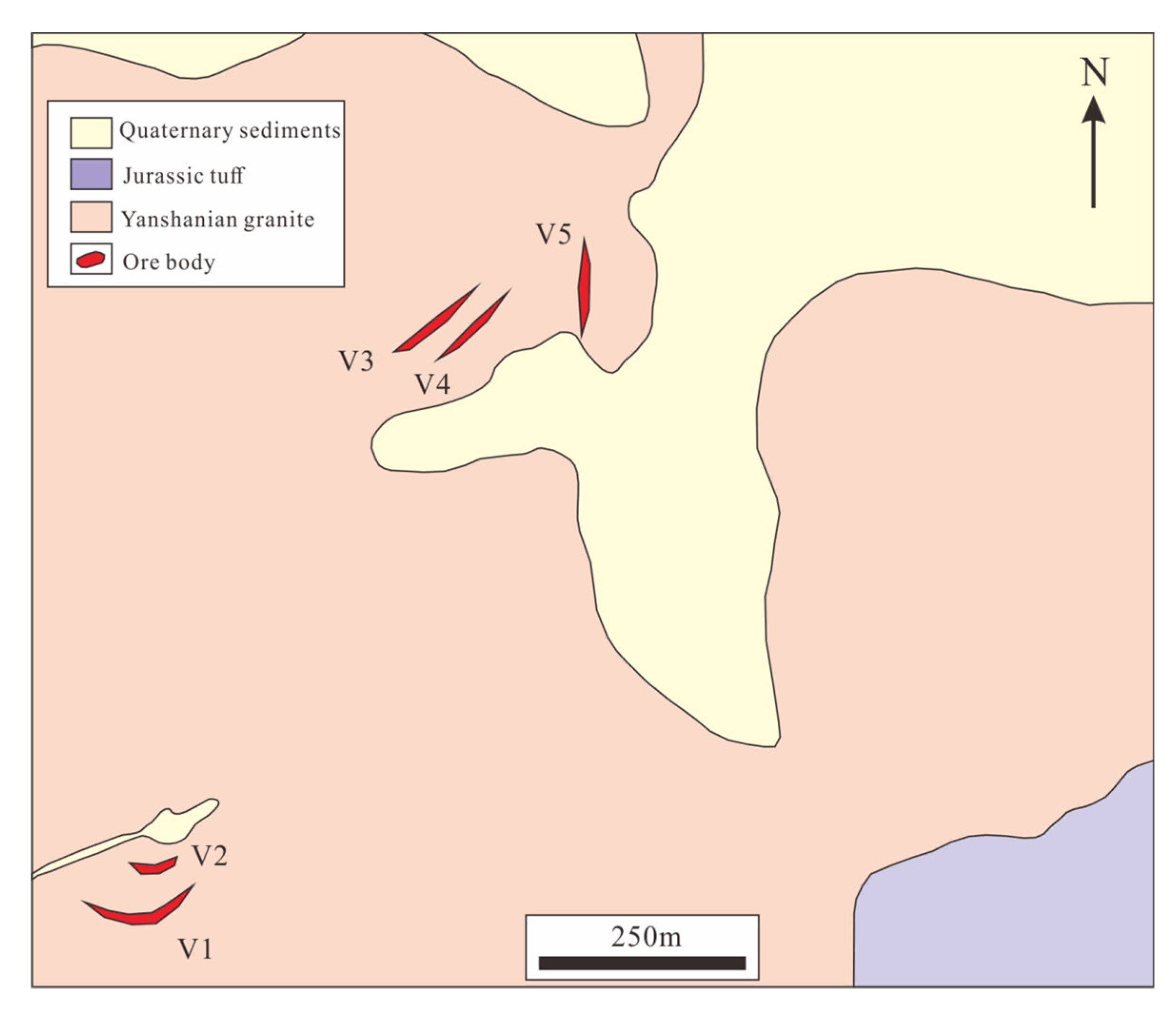
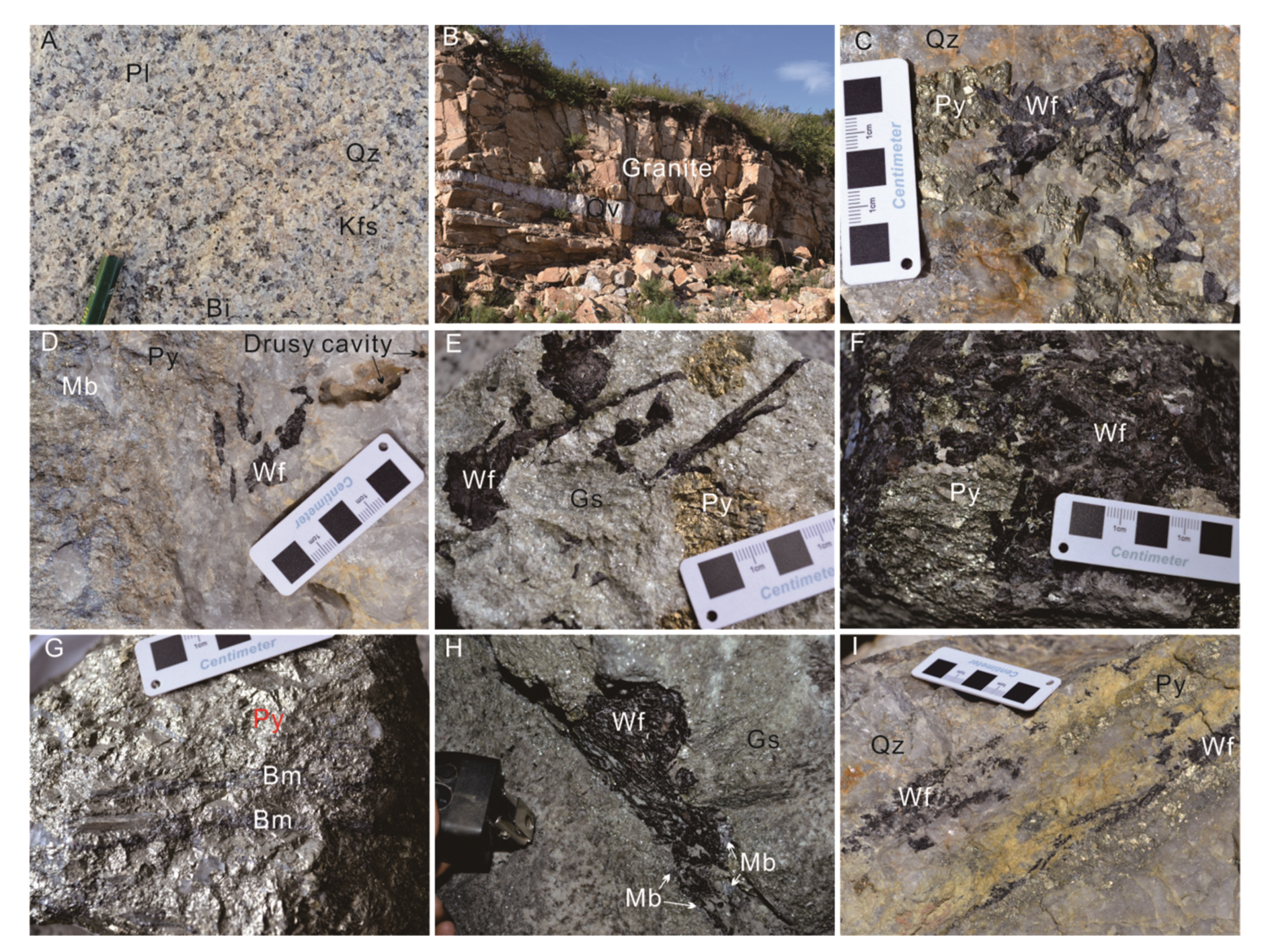
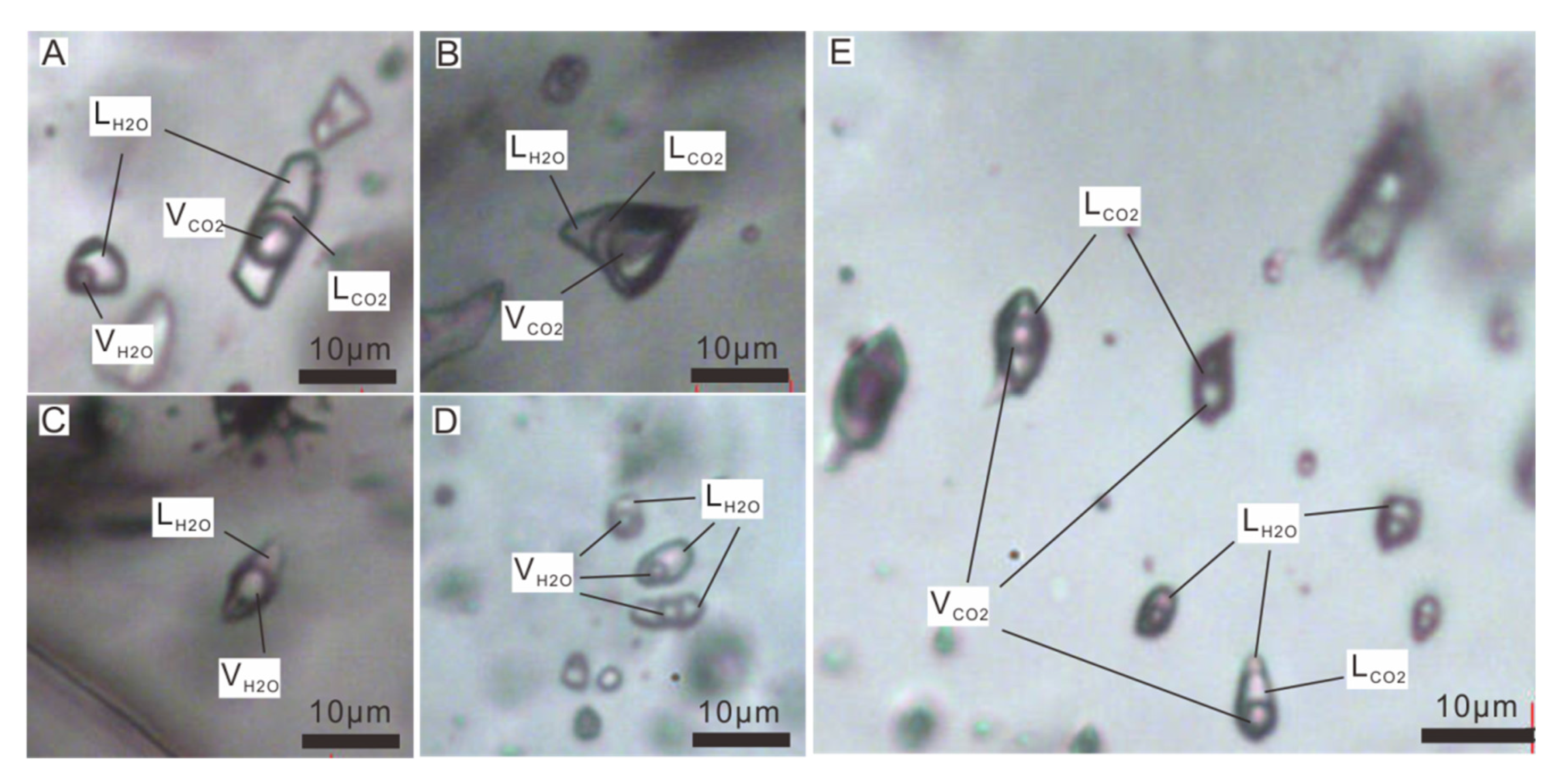
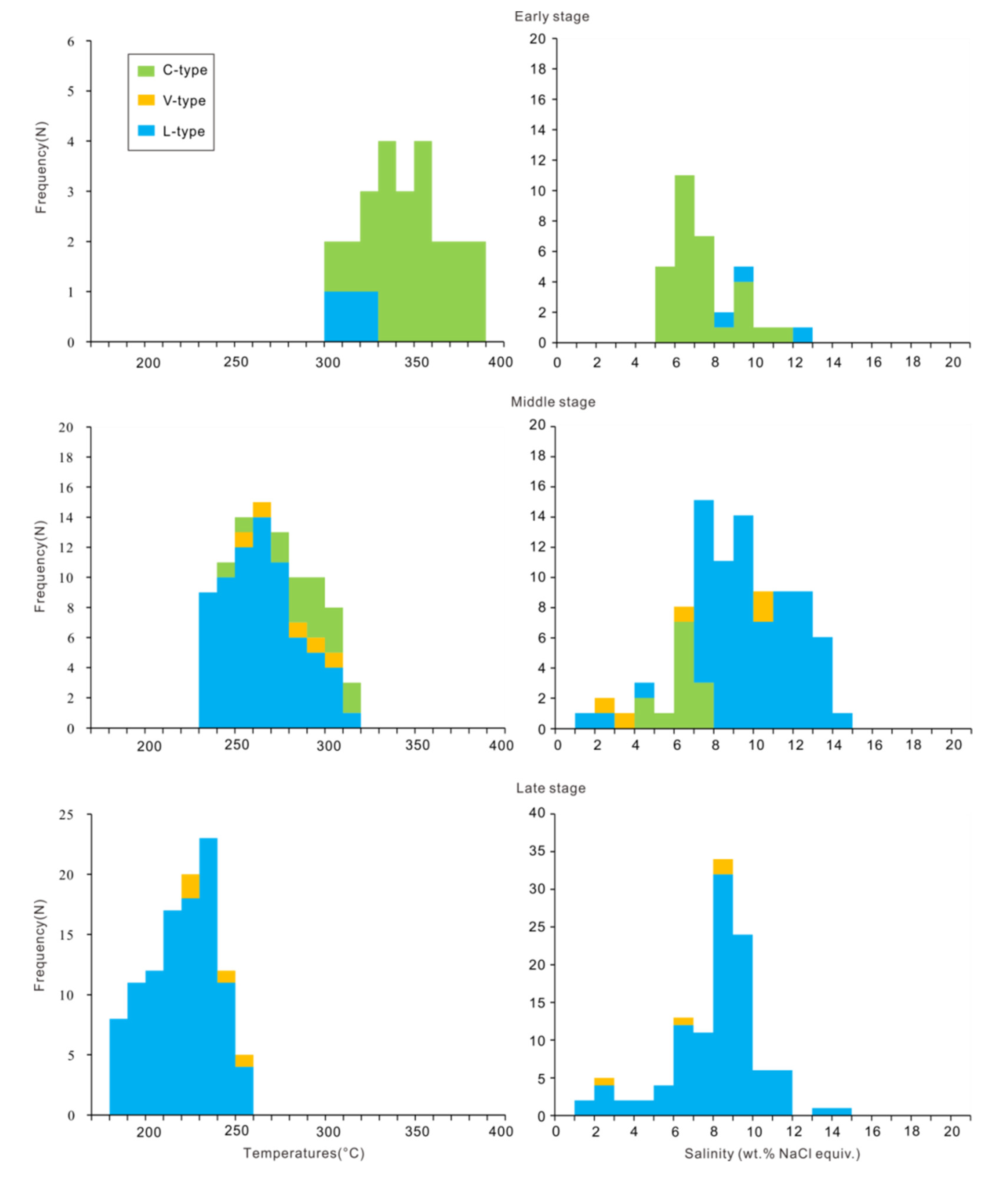
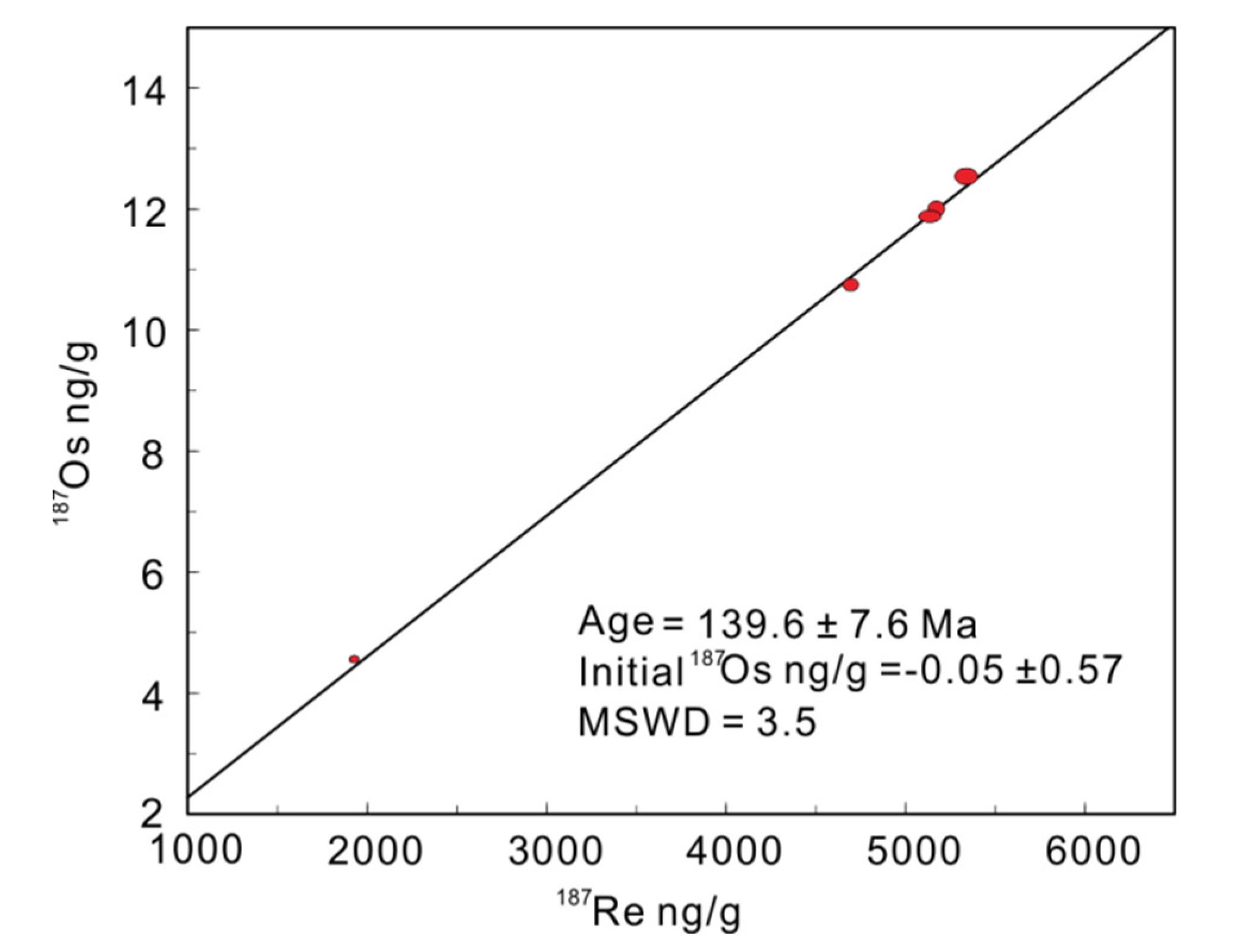
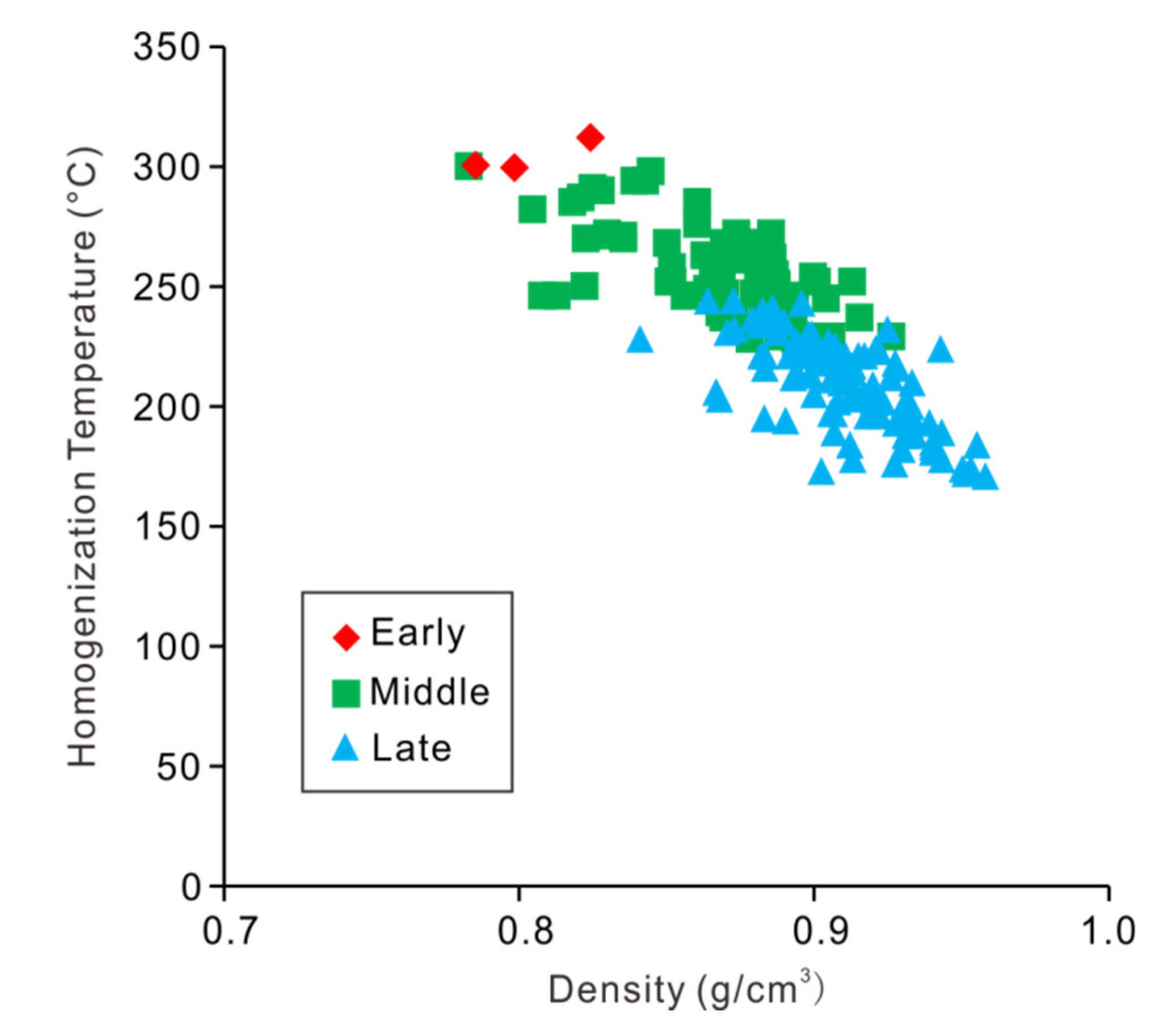
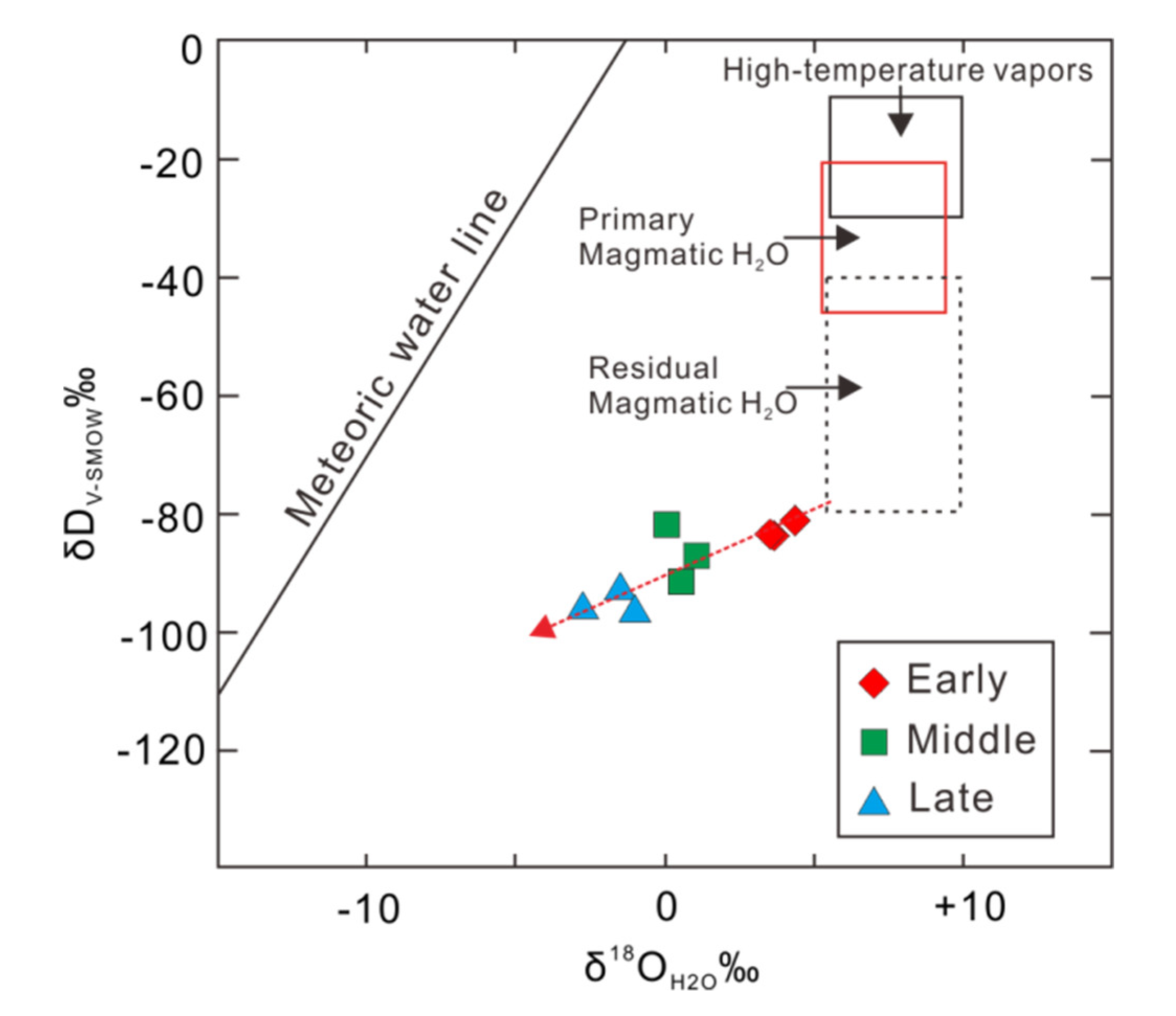
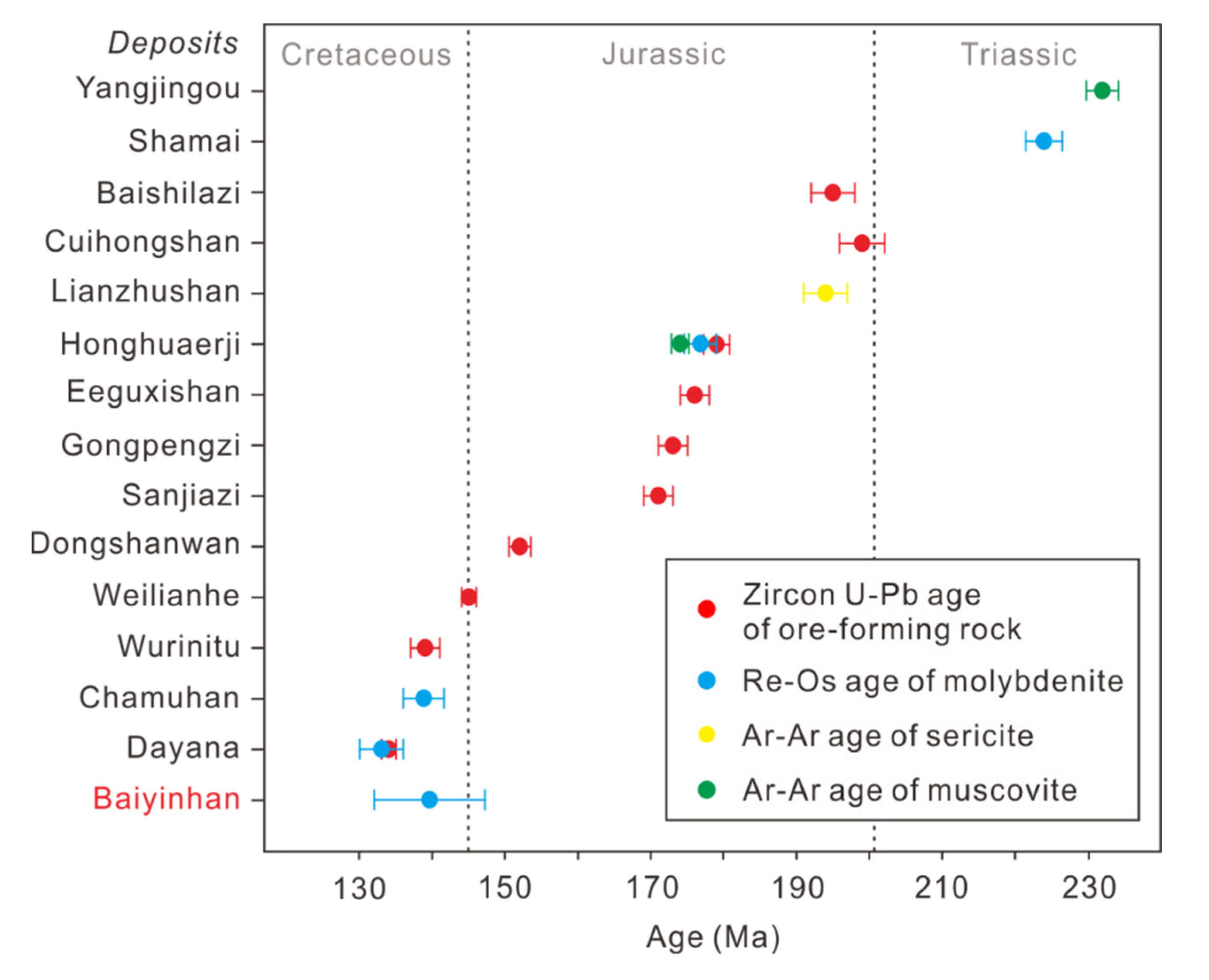
| Stage | Type | N | Tm-CO2 (°C) | Tm-ice (°C) | Tm-cla (°C) | Th-CO2 (°C) | Th-tot (°C) | Salinity (wt.%) | Pressure (bars) | Density (g/cm3) |
|---|---|---|---|---|---|---|---|---|---|---|
| I | L-type | 3 | −8.1 to −4.4 | 299–311 | 7.02–11.81 | 80–92 | 0.79–0.82 | |||
| C-type | 31 | −63.9 to −60.8 | 3.9–7.9 | 28.1–31.1 | 294–374 | 4.14–10.72 | ||||
| II | L-type | 72 | −9.5 to −0.5 | 228–298 | 0.88–13.40 | 25–82 | 0.78–0.93 | |||
| V-type | 5 | −6.6 to −0.6 | 248–297 | 1.05–9.98 | 35–82 | 0.72–0.88 | ||||
| C-type | 16 | −62.2 to −60.9 | 6.4–8.1 | 27.9–31.1 | 233–305 | 3.19–6.81 | ||||
| III | L-type | 103 | −9.4 to −0.3 | 171–244 | 0.53–13.29 | 8–34 | 0.84–0.96 | |||
| V-type | 4 | −5.0 to −0.6 | 210–245 | 1.05–7.86 | 14–36 | 0.81–0.91 |
| Sample No. | Mineral | Stage | δD (‰) | δ18Oquartz (‰) | Th (°C) | δ18Owater (‰) |
|---|---|---|---|---|---|---|
| 17BYH-8 | Quartz | Early | −81.65 | 9.96 | 338 | 4.3 |
| 17BYH-10 | Quartz | Early | −84.23 | 9.27 | 338 | 3.6 |
| 17BYH-31 | Quartz | Early | −83.68 | 9.20 | 338 | 3.5 |
| 17BYH-11 | Quartz | Middle | −91.76 | 9.32 | 255 | 0.6 |
| 17BYH-13 | Quartz | Middle | −82.06 | 8.83 | 255 | 0.1 |
| 17BYH-26 | Quartz | Middle | −87.37 | 9.82 | 255 | 1.1 |
| 17BYH-14 | Quartz | Late | −96.54 | 8.46 | 210 | −2.6 |
| 17BYH-16 | Quartz | Late | −97.07 | 10.16 | 210 | −0.9 |
| 17BYH-17 | Quartz | Late | −93.27 | 9.68 | 210 | −1.4 |
| Sample No. | Weight (g) | Re (ng/g) | Uncertainty | 187Re (ng/g) | Uncertainty | 187Os (ng/g) | Uncertainty | Model Age (Ma) | Uncertainty |
|---|---|---|---|---|---|---|---|---|---|
| BYH-13 | 0.03025 | 7464 | 57 | 4691 | 36 | 10.73 | 0.09 | 137.1 | 2.0 |
| BYH-14 | 0.03016 | 8486 | 82 | 5333 | 52 | 12.53 | 0.10 | 140.8 | 2.3 |
| BYH-15 | 0.03031 | 8223 | 60 | 5168 | 38 | 11.99 | 0.11 | 139.1 | 2.1 |
| BYH-16 | 0.03092 | 8169 | 78 | 5134 | 49 | 11.87 | 0.08 | 138.6 | 2.1 |
| BYH-18 | 0.0.001 | 3108 | 20 | 1953 | 13 | 4.52 | 0.03 | 138.7 | 1.9 |
© 2020 by the authors. Licensee MDPI, Basel, Switzerland. This article is an open access article distributed under the terms and conditions of the Creative Commons Attribution (CC BY) license (http://creativecommons.org/licenses/by/4.0/).
Share and Cite
Wang, R.; Zeng, Q.; Zhang, Z.; Guo, Y.; Lu, J. Fluid Evolution, H-O Isotope and Re-Os Age of Molybdenite from the Baiyinhan Tungsten Deposit in the Eastern Central Asian Orogenic Belt, NE China, and Its Geological Significance. Minerals 2020, 10, 664. https://doi.org/10.3390/min10080664
Wang R, Zeng Q, Zhang Z, Guo Y, Lu J. Fluid Evolution, H-O Isotope and Re-Os Age of Molybdenite from the Baiyinhan Tungsten Deposit in the Eastern Central Asian Orogenic Belt, NE China, and Its Geological Significance. Minerals. 2020; 10(8):664. https://doi.org/10.3390/min10080664
Chicago/Turabian StyleWang, Ruiliang, Qingdong Zeng, Zhaochong Zhang, Yunpeng Guo, and Jinhang Lu. 2020. "Fluid Evolution, H-O Isotope and Re-Os Age of Molybdenite from the Baiyinhan Tungsten Deposit in the Eastern Central Asian Orogenic Belt, NE China, and Its Geological Significance" Minerals 10, no. 8: 664. https://doi.org/10.3390/min10080664
APA StyleWang, R., Zeng, Q., Zhang, Z., Guo, Y., & Lu, J. (2020). Fluid Evolution, H-O Isotope and Re-Os Age of Molybdenite from the Baiyinhan Tungsten Deposit in the Eastern Central Asian Orogenic Belt, NE China, and Its Geological Significance. Minerals, 10(8), 664. https://doi.org/10.3390/min10080664





